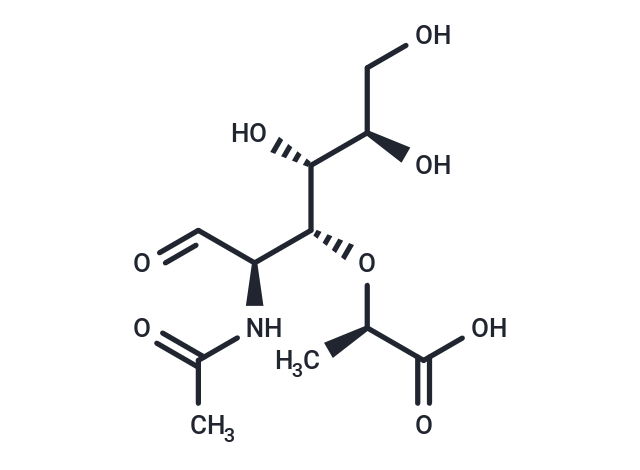Shopping Cart
Remove All Your shopping cart is currently empty
Your shopping cart is currently empty
Ac-muramic acid (MurNAc) is an essential component of bacterial peptidoglycan, the structural polymer of the cell wall. Ac-muramic acid is covalently linked to N-acetylglucosamine through β-1,4 linkages and may also be connected via the hydroxyl group on carbon-4 to the carbon atom of L-alanine, forming part of the peptide stem. MurNAc is central to bacterial cell wall biosynthesis studies.

| Pack Size | Price | USA Warehouse | Global Warehouse | Quantity |
|---|---|---|---|---|
| 2 mg | $29 | - | In Stock | |
| 5 mg | $49 | - | In Stock | |
| 10 mg | Preferential | - | In Stock |
| Description | Ac-muramic acid (MurNAc) is an essential component of bacterial peptidoglycan, the structural polymer of the cell wall. Ac-muramic acid is covalently linked to N-acetylglucosamine through β-1,4 linkages and may also be connected via the hydroxyl group on carbon-4 to the carbon atom of L-alanine, forming part of the peptide stem. MurNAc is central to bacterial cell wall biosynthesis studies. |
| In vitro | Methods: RAW264.7 cells were treated with Ac-muramic acid (100-300 μg/mL, 48 hours), and the expression of related proteins was analyzed by Western Blot. Results: Ac-muramic acid inhibited the expression of iNOS and COX-2 proteins. [1] |
| In vivo | Method: Ac-muramic acid (10-40 mg/kg, once daily for 28 consecutive days) was orally administered to E. coli-infected mouse models to investigate the anti-inflammatory effects of N-Acetylmuramic acid. Results: Ac-muramic acid inhibited intestinal villus edema and thickening in mice and increased the level of secretory immunoglobulin A (sIgA) in the intestinal tract of mice.[1] |
| Synonyms | NAMA, N-Acetylmuramic aci, MurNAc |
| Molecular Weight | 293.27 |
| Formula | C11H19NO8 |
| Cas No. | 10597-89-4 |
| Smiles | C[C@@H](O[C@@H]([C@H](O)[C@H](O)CO)[C@@H](NC(C)=O)C=O)C(O)=O |
| Color | White |
| Appearance | Solid |
| Storage | Powder: -20°C for 3 years | In solvent: -80°C for 1 year | Shipping with blue ice/Shipping at ambient temperature. | |||||||||||||||||||||||||||||||||||||||||||||
| Solubility Information | DMF: 2.5 mg/mL (8.52 mM), Sonication is recommended. H2O: 80 mg/mL (272.79 mM), Sonication is recommended. PBS (pH 7.2): 10 mg/mL (34.1 mM), Sonication is recommended. DMSO: 30 mg/mL (102.29 mM), Sonication is recommended. | |||||||||||||||||||||||||||||||||||||||||||||
Solution Preparation Table | ||||||||||||||||||||||||||||||||||||||||||||||
DMF/PBS (pH 7.2)/DMSO/H2O
PBS (pH 7.2)/DMSO/H2O
DMSO/H2O
| ||||||||||||||||||||||||||||||||||||||||||||||
| Size | Quantity | Unit Price | Amount | Operation |
|---|

Copyright © 2015-2025 TargetMol Chemicals Inc. All Rights Reserved.